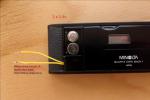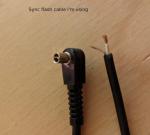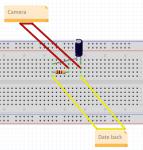Hello,
I'm slowly learning electronic and to do so I am working on a photography related project.
I love the date imprints on photographs and I want to attach an external date back on an analogue camera that doesn't have a date back (yet).
I've already extracted a date module from another camera and l’m able to manually trigger the date imprint process, but I'm having trouble to exploit the camera signal to imprint the date when a photo is taken.
It seems the signal (closing a circuit) sent by camera is too fast to be caught by my date module.
My date module looks like this :

The sync flash I use to receive the camera signal (originally used to trigger flashes):

Firstly, I tried connecting the yellow cables to the sync flash cables
- With one camera (Minolta) : It worked up to a certain shutter speed (1/125s).
- With another camera (Bessa), the one I want to use the date back on : It didn't work, no mater the shutter speed.
Conclusion: camera signal might be too fast I need to slow it down.
Secondly, I tried slowing down the signal using a resistor and a capacitor.
I had no idea what I was doing and tried different capacitor/resistor and had some successes.
Here is an illustration of the circuit :

With
0.1μF and
2KΩ- With the Minolta : It worked for every speeds ! \o/ .
- With the Bessa, (the one I want to use the date back on) : It didn't work, no mater the shutter speed.
Conclusion: electronic is a complicated science.
My question: How can I exploit the Bessa' signal to trigger the date imprinting?
I am sure the cable and Bessa are working properly since I'm able to trigger a flash using the same camera, cable and socket.
PS: There is this very cool video on how a date back works, for the curious :
Thanks for your help
